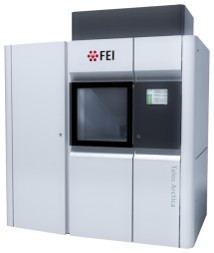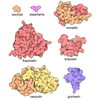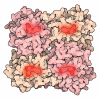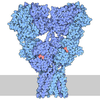[English] 日本語
 Yorodumi
Yorodumi- PDB-9utc: The VFT domains of human sweet taste receptor TAS1R2 and TAS1R3 i... -
+ Open data
Open data
- Basic information
Basic information
| Entry | Database: PDB / ID: 9utc | ||||||
|---|---|---|---|---|---|---|---|
| Title | The VFT domains of human sweet taste receptor TAS1R2 and TAS1R3 in the sucralose-bound state | ||||||
 Components Components |
| ||||||
 Keywords Keywords | SIGNALING PROTEIN / GPCR / Taste receptor / Tas1R2 / Tas1R3 / Sucralose | ||||||
| Function / homology |  Function and homology information Function and homology informationsweet taste receptor complex / detection of chemical stimulus involved in sensory perception of sweet taste / sweet taste receptor activity / taste receptor activity / sensory perception of umami taste / sensory perception of sweet taste / Class C/3 (Metabotropic glutamate/pheromone receptors) / positive regulation of cytokinesis / bioluminescence / G protein-coupled receptor activity ...sweet taste receptor complex / detection of chemical stimulus involved in sensory perception of sweet taste / sweet taste receptor activity / taste receptor activity / sensory perception of umami taste / sensory perception of sweet taste / Class C/3 (Metabotropic glutamate/pheromone receptors) / positive regulation of cytokinesis / bioluminescence / G protein-coupled receptor activity / Sensory perception of sweet, bitter, and umami (glutamate) taste / G alpha (i) signalling events / receptor complex / G protein-coupled receptor signaling pathway / Golgi apparatus / membrane / plasma membrane Similarity search - Function | ||||||
| Biological species |  Homo sapiens (human) Homo sapiens (human) Discosoma sp. (sea anemone) Discosoma sp. (sea anemone) | ||||||
| Method | ELECTRON MICROSCOPY / single particle reconstruction / cryo EM / Resolution: 3.33 Å | ||||||
 Authors Authors | Shi, Z.J. / Xu, W.X. / Yue, X.L. / Wu, L.J. / Hua, T. / Liu, Z.J. | ||||||
| Funding support | 1items
| ||||||
 Citation Citation |  Journal: Nature / Year: 2025 Journal: Nature / Year: 2025Title: Structural and functional characterization of human sweet taste receptor. Authors: Zongjun Shi / Weixiu Xu / Lijie Wu / Xiaolei Yue / Shenhui Liu / Wei Ding / Jinyi Zhang / Bing Meng / Lianghao Zhao / Xiaoyan Liu / Junlin Liu / Zhi-Jie Liu / Tian Hua /  Abstract: Sweet taste perception influences dietary choices and metabolic health. The human sweet taste receptor, a class C G-protein-coupled receptor (GPCR) heterodimer composed of TAS1R2 and TAS1R3 (refs. ), ...Sweet taste perception influences dietary choices and metabolic health. The human sweet taste receptor, a class C G-protein-coupled receptor (GPCR) heterodimer composed of TAS1R2 and TAS1R3 (refs. ), senses a wide range of sweet compounds-including natural sugars, artificial sweeteners and sweet proteins-and affects metabolic regulation beyond taste. However, the lack of three-dimensional structures hinders our understanding of its precise working mechanism. Here we present cryo-electron microscopy structures of the full-length human sweet taste receptor in apo and sucralose-bound states. These structures reveal a distinct asymmetric heterodimer architecture, with sucralose binding exclusively to the Venus flytrap domain of TAS1R2. Combining mutagenesis and molecular dynamics simulations, this work delineates the sweetener-recognition modes in TAS1R2. Structural comparisons further uncover conformational changes upon ligand binding and a unique activation mechanism. These findings illuminate the signal transduction mechanisms of chemosensory receptors in the class C GPCR family and provide the molecular basis for the design of a new generation of sweeteners. | ||||||
| History |
|
- Structure visualization
Structure visualization
| Structure viewer | Molecule:  Molmil Molmil Jmol/JSmol Jmol/JSmol |
|---|
- Downloads & links
Downloads & links
- Download
Download
| PDBx/mmCIF format |  9utc.cif.gz 9utc.cif.gz | 242.9 KB | Display |  PDBx/mmCIF format PDBx/mmCIF format |
|---|---|---|---|---|
| PDB format |  pdb9utc.ent.gz pdb9utc.ent.gz | 173.8 KB | Display |  PDB format PDB format |
| PDBx/mmJSON format |  9utc.json.gz 9utc.json.gz | Tree view |  PDBx/mmJSON format PDBx/mmJSON format | |
| Others |  Other downloads Other downloads |
-Validation report
| Summary document |  9utc_validation.pdf.gz 9utc_validation.pdf.gz | 470 KB | Display |  wwPDB validaton report wwPDB validaton report |
|---|---|---|---|---|
| Full document |  9utc_full_validation.pdf.gz 9utc_full_validation.pdf.gz | 488.3 KB | Display | |
| Data in XML |  9utc_validation.xml.gz 9utc_validation.xml.gz | 22.7 KB | Display | |
| Data in CIF |  9utc_validation.cif.gz 9utc_validation.cif.gz | 35.1 KB | Display | |
| Arichive directory |  https://data.pdbj.org/pub/pdb/validation_reports/ut/9utc https://data.pdbj.org/pub/pdb/validation_reports/ut/9utc ftp://data.pdbj.org/pub/pdb/validation_reports/ut/9utc ftp://data.pdbj.org/pub/pdb/validation_reports/ut/9utc | HTTPS FTP |
-Related structure data
| Related structure data |  64488MC  9ut8C  9ut9C  9utaC  9utbC M: map data used to model this data C: citing same article ( |
|---|---|
| Similar structure data | Similarity search - Function & homology  F&H Search F&H Search |
- Links
Links
- Assembly
Assembly
| Deposited unit | 
|
|---|---|
| 1 |
|
- Components
Components
| #1: Protein | Mass: 122191.227 Da / Num. of mol.: 1 Source method: isolated from a genetically manipulated source Details: Engineered red fluorescent protein mScarlet3: PMID: 27869816 and PDB ID: 7ZCT Source: (gene. exp.)  Homo sapiens (human), (gene. exp.) Homo sapiens (human), (gene. exp.)  Discosoma sp. (sea anemone) Discosoma sp. (sea anemone)Gene: TAS1R2, GPR71, T1R2, TR2 / Production host:  Homo sapiens (human) / References: UniProt: Q8TE23 Homo sapiens (human) / References: UniProt: Q8TE23 |
|---|---|
| #2: Protein | Mass: 124906.602 Da / Num. of mol.: 1 Source method: isolated from a genetically manipulated source Source: (gene. exp.)  Homo sapiens (human), (gene. exp.) Homo sapiens (human), (gene. exp.)  Gene: TAS1R3, T1R3, TR3, blFP-Y3 / Production host:  Homo sapiens (human) / References: UniProt: Q7RTX0, UniProt: A0A1S4NYF2 Homo sapiens (human) / References: UniProt: Q7RTX0, UniProt: A0A1S4NYF2 |
| #3: Polysaccharide | 4-chloro-4-deoxy-alpha-D-galactopyranose-(1-2)-1,6-dichloro-1,6-dideoxy-beta-D-fructofuranose |
| Has ligand of interest | Y |
| Has protein modification | Y |
-Experimental details
-Experiment
| Experiment | Method: ELECTRON MICROSCOPY |
|---|---|
| EM experiment | Aggregation state: PARTICLE / 3D reconstruction method: single particle reconstruction |
- Sample preparation
Sample preparation
| Component | Name: heterodimer / Type: COMPLEX / Entity ID: #1-#2 / Source: RECOMBINANT |
|---|---|
| Source (natural) | Organism:  Homo sapiens (human) Homo sapiens (human) |
| Source (recombinant) | Organism:  Homo sapiens (human) Homo sapiens (human) |
| Buffer solution | pH: 7.4 |
| Specimen | Embedding applied: NO / Shadowing applied: NO / Staining applied: NO / Vitrification applied: YES |
| Vitrification | Cryogen name: ETHANE |
- Electron microscopy imaging
Electron microscopy imaging
| Experimental equipment |  Model: Talos Arctica / Image courtesy: FEI Company |
|---|---|
| Microscopy | Model: FEI TALOS ARCTICA |
| Electron gun | Electron source:  FIELD EMISSION GUN / Accelerating voltage: 300 kV / Illumination mode: FLOOD BEAM FIELD EMISSION GUN / Accelerating voltage: 300 kV / Illumination mode: FLOOD BEAM |
| Electron lens | Mode: BRIGHT FIELD / Nominal defocus max: 2200 nm / Nominal defocus min: 1200 nm |
| Image recording | Electron dose: 60 e/Å2 / Film or detector model: GATAN K3 (6k x 4k) |
- Processing
Processing
| EM software | Name: PHENIX / Version: 1.20.1_4487 / Category: model refinement | ||||||||||||||||||||||||
|---|---|---|---|---|---|---|---|---|---|---|---|---|---|---|---|---|---|---|---|---|---|---|---|---|---|
| CTF correction | Type: PHASE FLIPPING AND AMPLITUDE CORRECTION | ||||||||||||||||||||||||
| 3D reconstruction | Resolution: 3.33 Å / Resolution method: FSC 0.143 CUT-OFF / Num. of particles: 84470 / Symmetry type: POINT | ||||||||||||||||||||||||
| Refinement | Highest resolution: 3.33 Å Stereochemistry target values: REAL-SPACE (WEIGHTED MAP SUM AT ATOM CENTERS) | ||||||||||||||||||||||||
| Refine LS restraints |
|
 Movie
Movie Controller
Controller






 PDBj
PDBj





